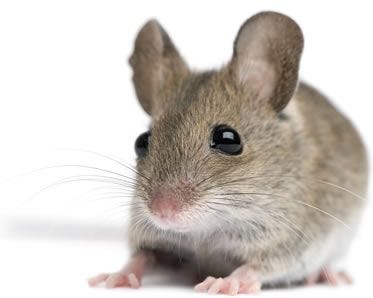





Mice
Mouse Facts
There are several species of mice, but the best-known species is the common house mouse. This type of creature is found in nearly all countries across the world, living in homes, ships, storage facilities, warehouses, farms and more. Learn all you need to know about the house mouse including where they live, what they eat, common signs of mice and health concerns.

General Mouse Facts
- Scientific Name: Mus musculus
- Average Size: 5-8" long with 2-4" tail; 0.4-0.8 oz.
- Average Lifespan in the Wild: less than 1 year
- Identifying Features: light brown or grey fur; pointed nose; small black eyes; large ears; scaly, hairless tail.
Mouse Geography

The house mouse is found all over the world, except for Antarctica. Mus musculus has roots in central Asia, but because of its extraordinary adaptability, its range has expanded to the rest of the globe - following the migration path of humans.

Mouse Habitat
Most house mice are commensal - living in close proximity to humans and relying on us for food and shelter. They make themselves at home in and around houses, barns, warehouses, granaries, fields and farms. In cooler weather, they almost always make their way indoors for warmth.
Nests are made in dark, quiet spaces, like in between walls, cabinets, closets, basements, attics, storage areas, rafters etc. Each mouse remains within about 10 feet of its nest at all times, so nests are almost always found within this distance of a food source.
Mouse Diet
Seeds and grains are a house mouse's main dietary staples, although mice are opportunistic omnivores that ultimately eat a wide variety of foods. Mice are especially fond of foods that are high in fat, protein, and even sugar. Even though mice only eat about 1/10 of an ounce of food per day, they may bite open several food packages for sampling.
Some favorite foods include:

Mouse Behavior
- Activity: Sensitive to bright lights, mice are generally nocturnal or crepuscular (active during twilight). A mouse's range of activity is usually confined to an area with an average radius of 10 feet.
- Reproduction: Reproduction begins at 6-10 weeks of age, and each female can give birth to as many as 10 litters per year. After a short gestation period of 20 days, litters of 5 to 6 young are born and the cycle begins again.
- Exploration: Using superior senses of hearing, smell, taste and touch, a mouse becomes an expert of its range by learning and memorizing the locations of food, pathways and obstacles. When a new object enters its range, a mouse is usually unafraid to explore it.
- Social Interaction: Mice live in colonies, or family groups. Each colony establishes its own territory by urine and feces marking.
Identify Mouse Damage
Mice are tiny and swift, and their range is small, so they generally remain out of sight when living with humans. It's important to identify signs of mice and their damage in order to protect your home.
Signs of a mouse infestation include:

- holes in food packaging or other types of packaging
- ripped paper, cardboard, clothing or other fibrous material
- mouse nest: ball of soft, shredded material about 5" in diameter
- small tooth marks on wooden baseboards, cabinets, windowpanes, doors, etc.
- grease marks on walls, baseboards, cabinets, windowpanes, doors, etc.
- mouse droppings: seed-shaped droppings about 1/4" long; black and wet when fresh, greyish and dry when old.
- mouse tracks: tiny prints less than 1/2" in length; four toes on front paws and five in back.
Mice and Diseases
There are a myriad of disease agents and diseases mice carry that may be transmitted to humans or pets. Because house mice live in close quarters with humans, this potential poses a reasonable threat to home and business owners.
Diseases transmitted by the common house mouse include:
- Lyme disease
- leptospirosis
- salmonella
- murine typhus
- bubonic plague
- lymphocytic choriomeningitis (LCM)
Additional illnesses transmitted by other types of mice - like the deer mouse or white-footed field mouse - include:
- hantavirus
- hemorrhagic fever
- rat-bite fever
These diseases are transmitted via:
- mouse bites or scratches
- ingesting food or water contaminated with mouse urine or droppings
- inhaling dust contaminated with urine or droppings
- direct contact with an infected animal or its excrement
- bites from infected fleas, ticks or mites
Mice are constantly exploring and leaving behind urine, feces and hairs in our food and clothing. It's important to protect your home or business from mice to avoid contact with any of these diseases or disease-causing agents.
Fun Facts
- One house mouse produces up to 36,000 droppings per year.
- Mice are colorblind.
- In ideal conditions, one pair of mice and their offspring can produce up to 8,000 young in one year.
- A mouse can squeeze through a hole the size of half a dime.
- Whiskers help a mouse feel out its surroundings and can even detect temperature change.
- A mouse uses its tail for balance, allowing it to travel along very narrow wires and ropes.
- A group of mice is called a "mischief".
